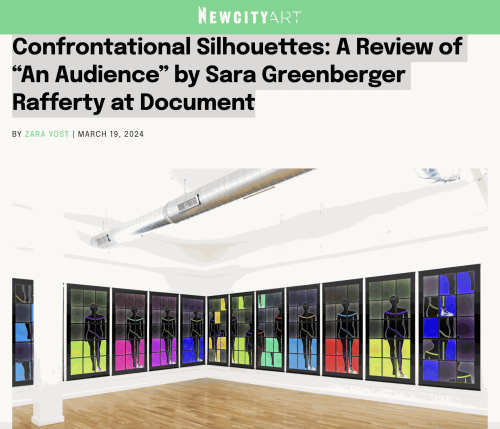“An Audience” by Sara Greenberger Rafferty details large sculptures of kiln-fired glass fused together with photographic images. These innovative artworks are complemented by unframed contact prints, a form of cameraless images that showcase various combinations of form and color. Rafferty, a Brooklyn-based artist, is known for her creative practices featuring photography and sculptures. She has been included in collections like the Museum of Modern Art, the Whitney Museum of American Art and the Carnegie Museum of Art, to name a few. Rafferty’s latest exhibition continues to demonstrate her artistic originality.
This is Rafferty’s fourth exhibition at Document. “An Audience” showcases twelve laminated inkjet prints arranged in panels to resemble large windows alongside three fused and kiln-formed glass wall-relief sculptures. Each windowed print portrays a female silhouette. The shadowed figure in each window is highlighted by one of several neon colors, such as pink, red, green, yellow and blue, which then fades into a darker, more muted pigmentation. A measuring tape drapes across the collarbones, hips and down the left leg of each silhouette. Additionally, every left foot has a lone boot. The booted foot is an inverted image as if it were on an X-ray illuminator.
The silhouettes loom over the gallery-goer… or are we watching them? In Rafferty’s artistic messaging, we are the spectators and the spectated. One body after another, these fifteen outlines float against gallery walls like light apertures. The faceless silhouettes represent countless women whose bodies have been picked apart and objectified in the digital age. Throughout history, women have been reduced to mere objects of desire. Their bodies have been gazed upon and coveted for one thing or another, be it a specific body part—an arm or a leg—their overall appearance, or even just their existence.
This has contributed to a culture where women are often judged solely on their physical attributes rather than their intellect, skills or character. The objectification of women has also led to a range of mounting issues, including harassment, discrimination, and a lack of representation in various fields. Women are often compared to digitally altered images that don’t represent reality. Tools like Photoshop, Facetune and filters are used to splice, shrink and smooth over women’s bodies, giving an unrealistic standard of beauty. Rafferty’s silhouettes stand ominously and empty, ready for their measurements.
According to the White House Gender Policy Council, “An estimated eighty-five percent of women and girls globally have experienced some form of online harassment and abuse,” and “here in the United States, one in three women under the age of thirty-five—and over half of LGBTQI+ individuals—report experiencing sexual harassment and stalking online.” The sheer magnitude of the numbers is truly unprecedented.
In her work, Rafferty delves into the intricate and complex nature of the figure. She does this by employing a unique technique of flattening the female form, which emphasizes the objectification women have been subjected to throughout history. By using silhouettes, Rafferty signals the countless times women’s bodies have been gazed upon and reduced to mere objects or images of desire. Her work often encompasses themes of the body, commercialism and satire. Of the twelve main reliefs, only a few appear to be rearranged, separating the head from the torso or the foot from the leg as if the figure were on an X-ray illuminator. The jumbled limbs are reminiscent of a crime scene, evoking fear in the context of violence against women.
A single boot is the only article of clothing on any of the silhouettes, and the phrase, “gets the boot” comes to mind. The statement alludes to a sardonic perspective on the reality that women frequently encounter obstacles and challenges that prevent them from achieving their goals. It implies a sense of irony and cynicism regarding the systemic discrimination and biases that exist in society, which often result in women being held back, marginalized or murdered.
Rafferty’s artwork has an unsettling effect: to witness the watched and to be in the liminal space of being both the audience and subjected to an audience. Rafferty is consistent with her interest in the body, consumerism and comedy from her past works. The term “an audience” encompasses a wide range of contexts. One of its meanings relates particularly to the spectators in a comedy show. In such a scenario, the audience is not just a passive observer but an active participant in the performance. The comedian, while performing, evaluates the audience’s reactions and adapts their act accordingly. Conversely, the audience also judges the comedian and provides feedback through their laughter or lack thereof, aka sizing up, or in Rafferty’s case, measuring the audience and vice versa. Thus, the term “an audience” in the context of a comedy show denotes a dynamic and interactive relationship between the performer and the spectators. The statement made by the artist in her work, “Glass Figure One—I Don’t Give a Fuck,” suggests that she is aware of the fact that she may be subjected to criticism and judgment by both the critics and the society at large. However, she appears unfazed by this prospect and instead seems determined to create her own audience, even among those who judge her work. This can be seen as a bold and confident move on the part of Rafferty, as she is essentially taking ownership of her own art and refusing to be swayed by the opinions of others.
